When everything goes well, there isn’t a lot of bonsai work this time of year. Deciduous trees are recovering from their last pruning of the season, decandled pines are filling in, and tropical bonsai are getting their final cutback of the season.
That said, the next month is pivotal for improving and maintaining tree health. It’s the last opportunity for fertilizing trees before they go dormant or applying systemic pesticides and fungicides. It’s when wires cut in and caterpillars are hungry. In short, it’s the last chance of the year to steer our trees toward greater health and away from subtle decline.
Here are some of the late summer tasks I’m currently working on.
Targeted fertilizing
I like giving most trees in the garden ample fertilizer before they go dormant to help them grow strong the following spring. But for some species like black pines, I dole out fertilizer based on each tree’s needs.
Here’s a decandled pine with small summer buds. Because the buds are so small, I’ve already started to fertilize.
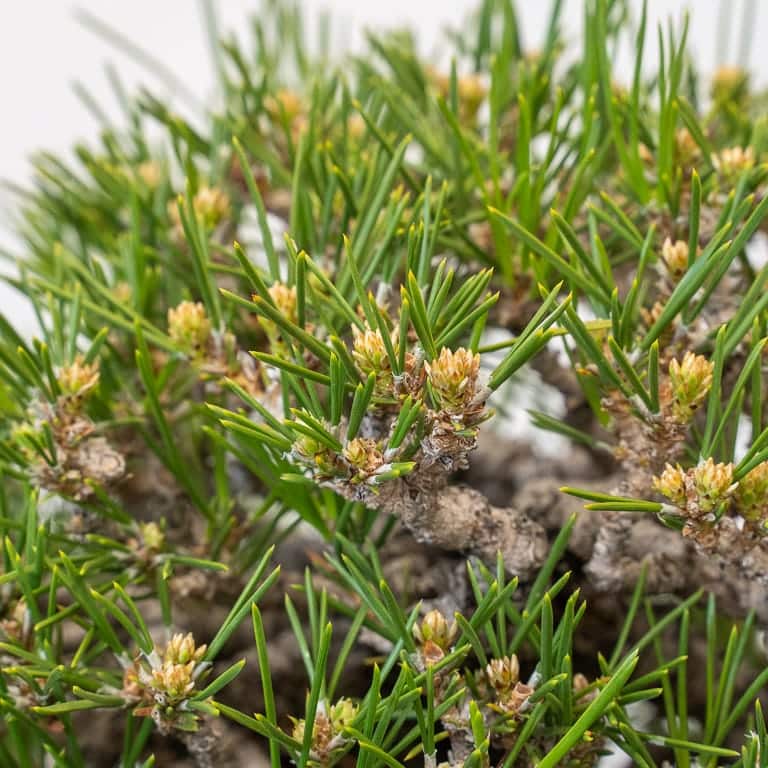
Small summer buds on black pine
When the summer buds are really vigorous, I hold off until later in the season before I start fertilizing.
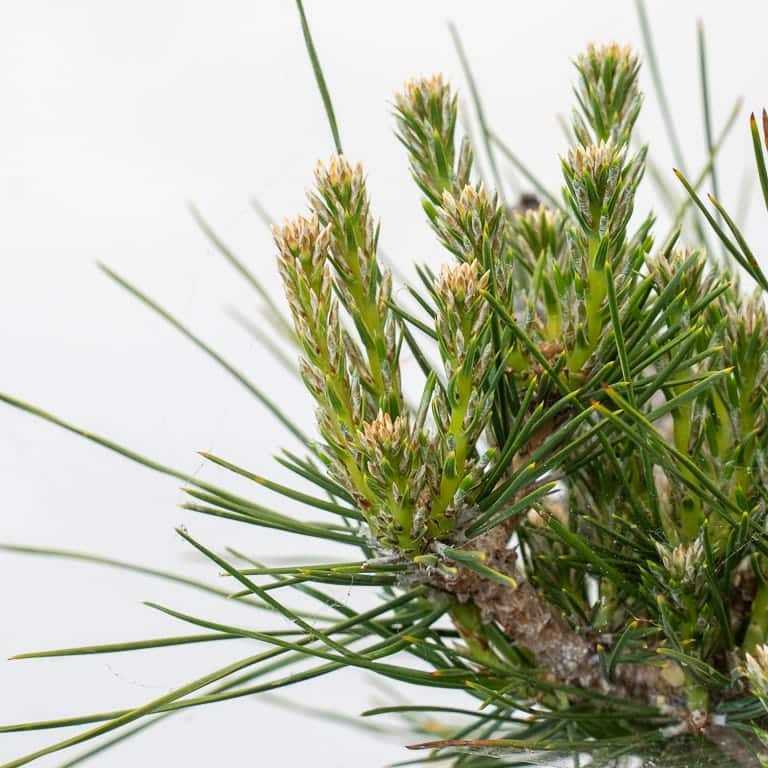
Strong summer growth
I’ll start fertilizing the pine above in mid- to late-September.
For the rest of the trees in the garden, I’m fertilizing regularly with liquid and/or solid fertilizers.
Pest control
Aphids, thrips, and mealybugs can be trouble year-round, but some insects are most active in summer. I’m always on the watch for spider mites as they like hot and dry conditions and reproduce quickly. To keep their numbers down, I overhead water conifers as this can help wash the mites away.
Another pest that can be problematic this time of year is the caterpillar. Here’s a photo showing typical caterpillar damage.
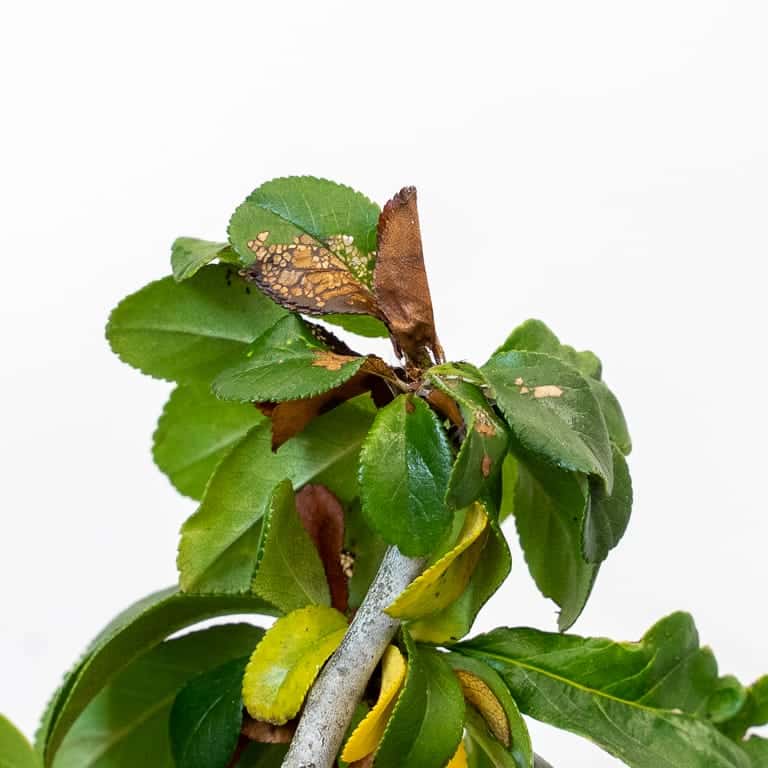
Caterpillar damage on flowering quince
Leaves that are stuck together are a sure sign of caterpillars. If you peel the leaves apart in time, you might find the culprit.

Can you see the caterpillar? (It’s on the margin between the dark and pale portions of the leaf)
I like to keep the insect numbers down this time of year as plants don’t respond as well to insect damage when they’re dormant. Late summer and fall are also the last chances we get to apply systemic pesticides as trees don’t absorb pesticides as well when they are dormant.
Fungal pathogens
Late summer is also a great time to get ahead of fungal pathogens. Some of these attack the foliage, others make trouble for the roots.
Here’s an example of damage caused by a foliar pathogen.
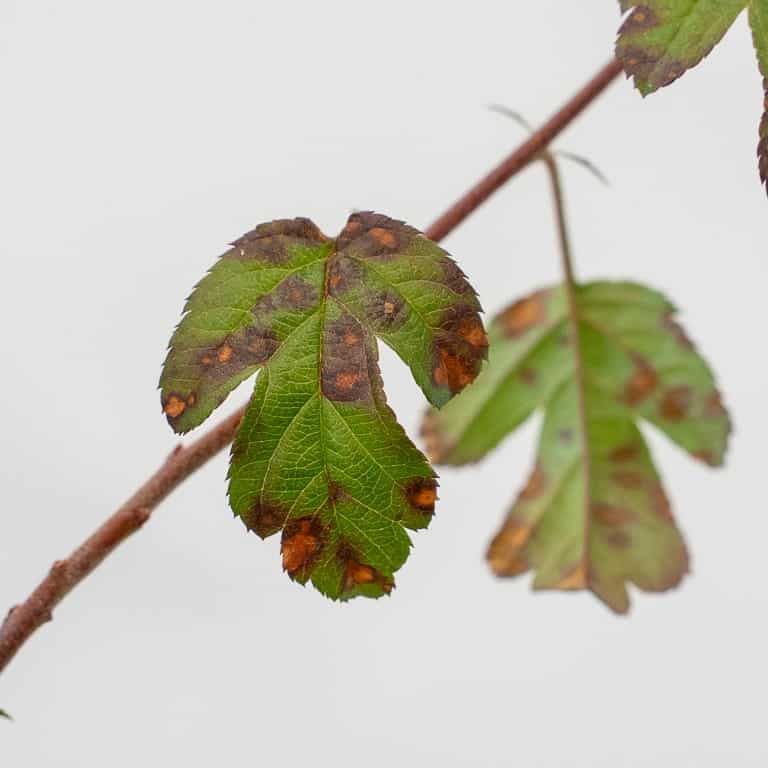
Spots on crabapple leaves likely caused by a foliar fungus
When leaf damage is random on the leaf surface, fungal pathogens are a likely culprit. When the tips of leaves are damaged, the problem is usually in the soil. Here are examples of symptoms that likely result from “root unhappiness,” as a local plant pathologist put it.
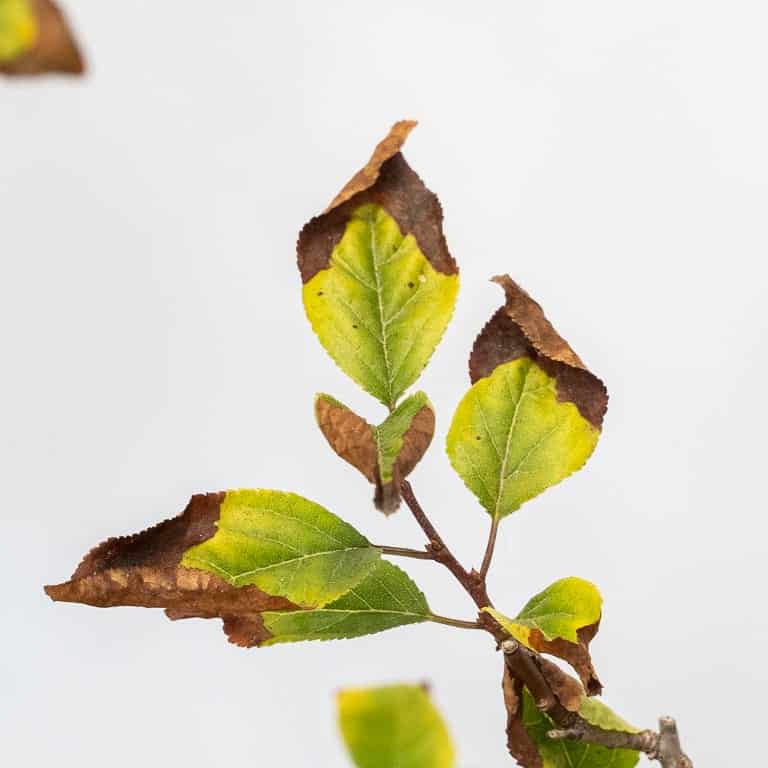
Brown tips
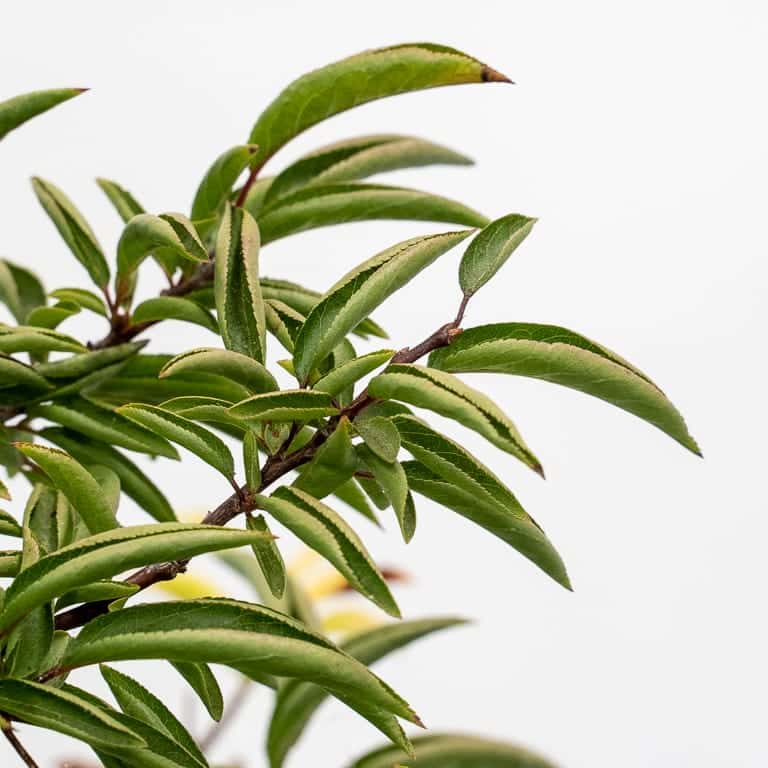
Curled leaves
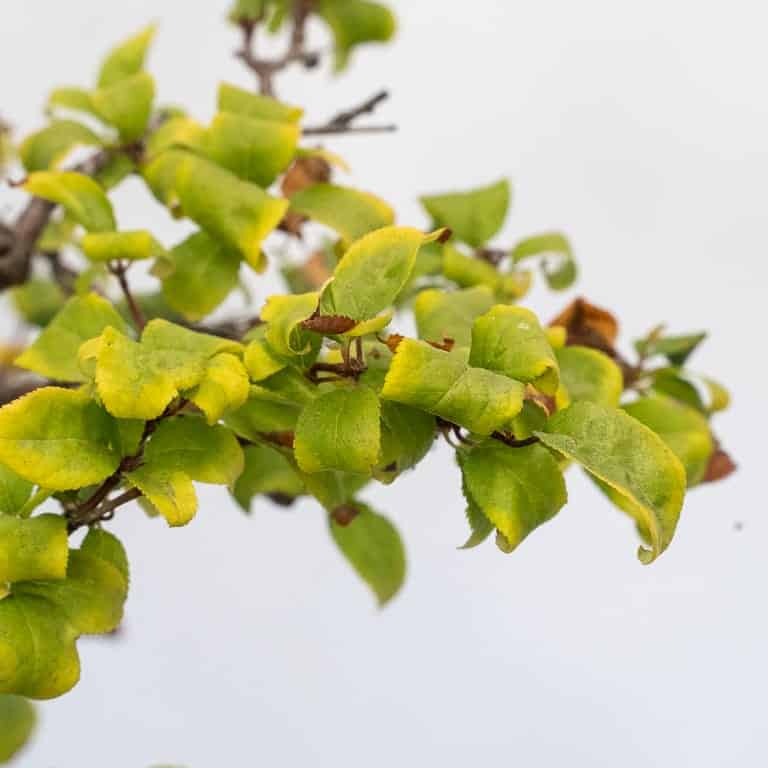
Yellow leaves that curl downward
Chlorosis is a related problem as iron deficiency can result from a variety of root problems ranging from pathogens to poor drainage.
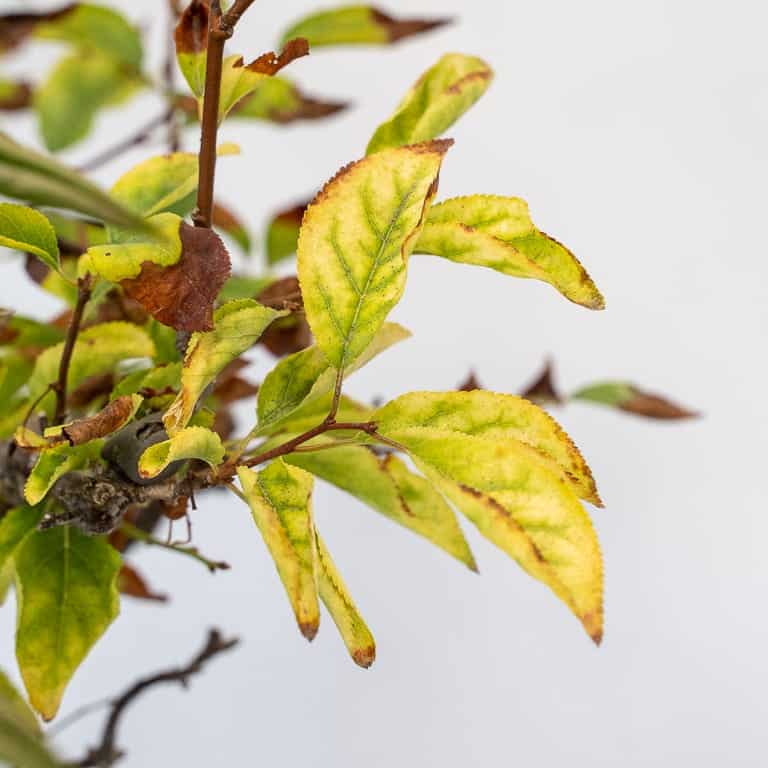
Yellow leaves
The above examples are all from plums planted in the same container. As many of the leaves are in poor shape, now is the time to fertilize and treat any underlying problems before the leaves completely fall off.
Wire scars
Any trees that are actively growing can cause swelling that leads to wire scars. Limited scarring is OK in some cases, but deep scars are rarely acceptable.
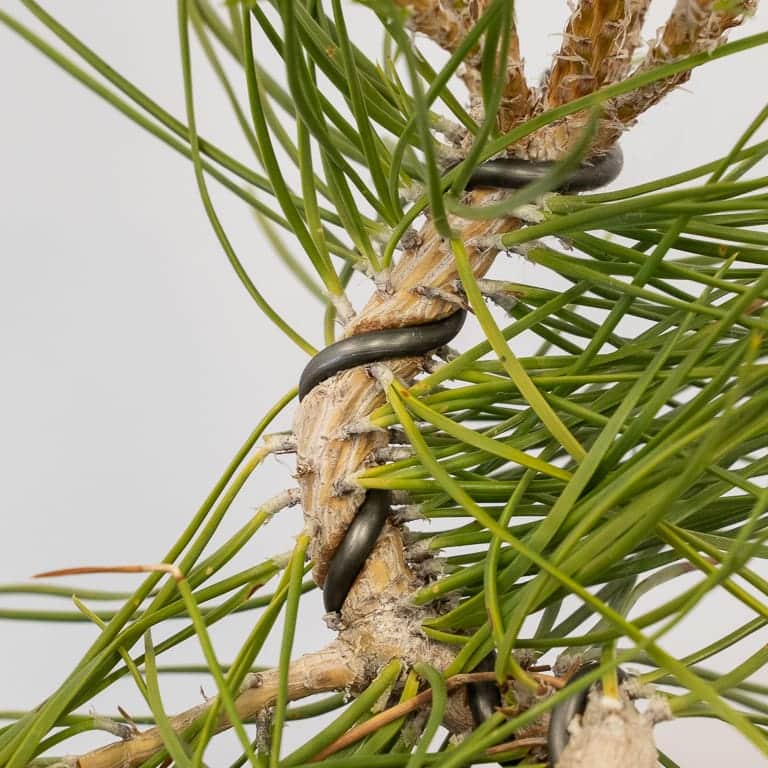
Wire scar on black pine
Using flags or colored tape to indicate trees with wire can be a good reminder to check and see if swelling branches need attention.
Watering and heat protection
Late summer can bring high temperatures that require careful watering. Some trees need more water when it gets hot while others shut down to conserve resources. I check the soil more often on hot days as I’m often surprised which trees dry quickly and which don’t need as much water.
When the temperatures reach summer highs, I take a variety of steps to protect them from sunburn or general stress. For details, see “How to care for bonsai during heat waves.“
Unsolved mysteries
Late summer and fall are often our last chances for the year to use leaves as a clue to figure out why a tree might be unhealthy. Deciduous trees lose their leaves in fall and many conifers turn yellow in winter which makes troubleshooting difficult.
I found several yellow pines in a flat that was otherwise healthy which made me suspect root aphids, but after a quick check, I didn’t find any pests in the soil.
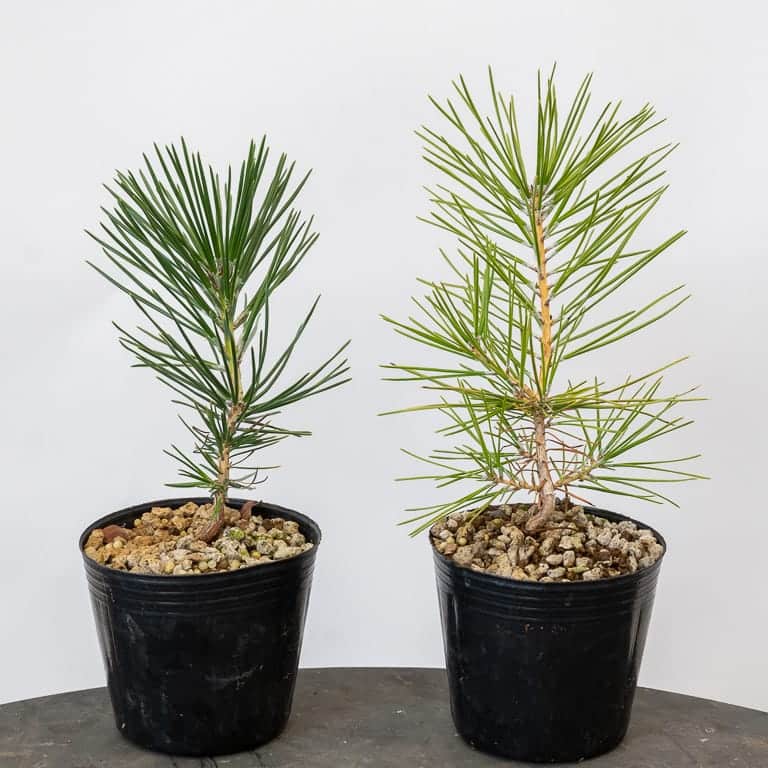
A healthy pine and an anemic pine
Given that the pines are in the same soil, on the same table, and getting the same water and fertilizer tells me it’s time to investigate further. For starters, I’ll isolate the yellow trees and water them less to rule out over-watering. I’ll also check more closely for root aphids. Beyond that, I’ll make sure these trees receive ample fertilizer to help with the chlorosis.
The above items are only a partial list of things to check in late summer. Feel free to add your own suggestions in the comments below!
News and Updates
- The upcoming U.S. National Bonsai Exhibition in Rochester is sold out. The event will be held as planned but tickets will not be available at the door. For a complete update about the show plus information about two private bonsai collections coming up for sale, see the recent update from the Valavanis Bonsai Blog.
- A new episode of the Bonsai Wire podcast is available: catch the discussion between host Andrew Robson and Sergio Cuan at bonsaiwirepodcast.com.
- My annual tree sale will run for one more week – shop the sale here.
Subscribe to Bonsai Tonight
New Posts Delivered Every Tuesday and Friday
Victor Taboada says
Hi Jonas, what do you suggest doing about those foliar fungus? I have a Crape Myrtle under training and it has been ravaged (very quickly) by some sort of mold/fungus.
Unfortunately Crape Myrtles, depending on the cultivar, are an easy pray to these fungal and insect problems.
Jonas Dupuich says
Hi Victor – I’d run down the basic list for foliar problems. I’d make sure I’m not getting the foliage wet when I water and I’d try not to keep the soil too wet either. I’d also make sure the tree is getting enough light. If I know what the pathogen is, I’d treat for it (e.g. milk sprays can work for powdery mildew, treating insects helps with sooty mold). If I don’t know what the problem is, I’d try something gentle like a copper spray (after checking the label to make sure it’s OK for crape myrtle) and see how that works.
Wabi47 says
Great post (and as usual great photos)….a reminder to pay more attention during the summer doldrums. A wise man once told me that the trees will tell you when they are unhappy. Unfortunately, when i am distracted, they may need to scream out.
Jonas Dupuich says
Thanks! I’ve heard the same advice – the trick is figuring out how to “listen” well to what the trees are trying to tell us.
Wabi47 says
sheesh…..you were that wise man a couple of years ago. I just realized then, that i needed to be a better listener.
Quhui says
hi,Jonas, thanks so much of your precious work! but there is something that i found: is the pine in the picture “Strong summer growth” infected red spider?
Jonas Dupuich says
Thanks for the heads up Quhui! The webs in the photo appear to be from larger spiders – there are lots in the garden this time of year!
Mert Ciftdemir says
Hi Jonas,
Thank you for this very helpful and guiding post. Today I’ve noticed brown colored tiny spots on fresh leaves of my cork oak pre-bonsai. Yesterday there was nothing. Is it something fungal?
Jonas Dupuich says
A number of things can cause spots on oaks. Fungus, especially on young leaves, galls, and some pests can leave spots on the leaves. I avoid overhead watering oaks as they can easily get fungus, and even without overhead watering, high humidity can have the same effect.